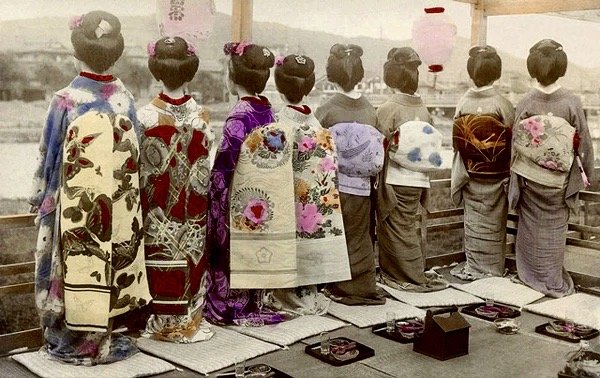 Image 1 of 7
Image 1 of 7

 Image 2 of 7
Image 2 of 7

 Image 3 of 7
Image 3 of 7

 Image 4 of 7
Image 4 of 7

 Image 5 of 7
Image 5 of 7

 Image 6 of 7
Image 6 of 7

 Image 7 of 7
Image 7 of 7








Japanese Obi Collection
The obi is a broad sash which wraps around one’s waist, while wearing the traditional Japanese kimono (or yakuta). Initially, the obi was purely practical, a narrow belt which held the kimono in place. But during the Edo period (1600-1868), the obi really came into its own. A combination of factors, including innovations in weaving, government regulations on dress, and the influence of the kabuki theater led to the obi becoming a serious statement piece. Women’s obi in particular morphed from purely practical to absolutely fabulous. Nowadays, formal obi are often 12 inches wide, and more than 12 feet long!
Originally, obi were tied in the front. But as they got wider, the knots got bigger; they gradually migrated to the back, and became purely decorative. The origami-like knots are called musubi, and there are hundreds of styles to choose from. Musubi are named for their resemblance to flowers, birds, etc. (examples include the “drum knot,” “butterfly knot,” “morning glory knot,” “sparrow knot,” etc.). Thankfully, many musubi-tying demonstrations are available on-line!
Informal obi are usually plain silk. However, formal occasions (such as weddings, and other important rituals) require special obi. These are typically made of heavily-embroidered silk brocade, interwoven with metallic fibers. The central obi in this collection is a Maru obi ("one-piece obi"), and has two fully-embroidered layers sewn together. Maru obi are considered rather old-fashioned; they are worn primarily by brides, and by some maiko (apprentice geisha).
The other four are Fukuro obi ("pouch obi"), dating from the mid-20th century. They are fully-embroidered on one side, and only partially on the reverse, in order to make then lighter, and to make the tying of the musubi easier.
Dimensions: Maru obi: 149" (12.4') x 12”. Fukuro obi: 169” (14’) x 12” Sold as a set of five. As can be seen in the first photo, they make a lovely display as textile art!
The obi is a broad sash which wraps around one’s waist, while wearing the traditional Japanese kimono (or yakuta). Initially, the obi was purely practical, a narrow belt which held the kimono in place. But during the Edo period (1600-1868), the obi really came into its own. A combination of factors, including innovations in weaving, government regulations on dress, and the influence of the kabuki theater led to the obi becoming a serious statement piece. Women’s obi in particular morphed from purely practical to absolutely fabulous. Nowadays, formal obi are often 12 inches wide, and more than 12 feet long!
Originally, obi were tied in the front. But as they got wider, the knots got bigger; they gradually migrated to the back, and became purely decorative. The origami-like knots are called musubi, and there are hundreds of styles to choose from. Musubi are named for their resemblance to flowers, birds, etc. (examples include the “drum knot,” “butterfly knot,” “morning glory knot,” “sparrow knot,” etc.). Thankfully, many musubi-tying demonstrations are available on-line!
Informal obi are usually plain silk. However, formal occasions (such as weddings, and other important rituals) require special obi. These are typically made of heavily-embroidered silk brocade, interwoven with metallic fibers. The central obi in this collection is a Maru obi ("one-piece obi"), and has two fully-embroidered layers sewn together. Maru obi are considered rather old-fashioned; they are worn primarily by brides, and by some maiko (apprentice geisha).
The other four are Fukuro obi ("pouch obi"), dating from the mid-20th century. They are fully-embroidered on one side, and only partially on the reverse, in order to make then lighter, and to make the tying of the musubi easier.
Dimensions: Maru obi: 149" (12.4') x 12”. Fukuro obi: 169” (14’) x 12” Sold as a set of five. As can be seen in the first photo, they make a lovely display as textile art!